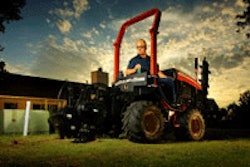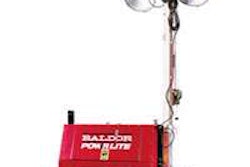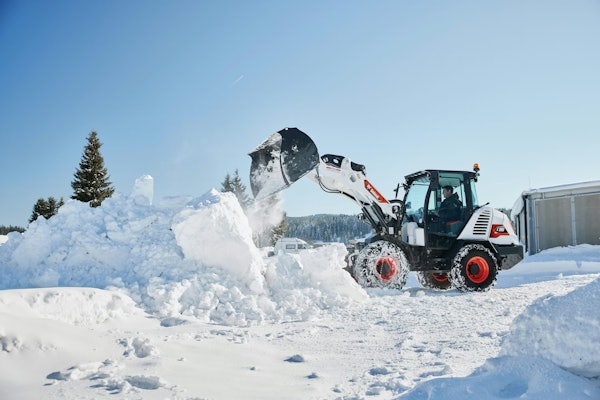Intelligent Compaction (IC) comes from both intelligent machines and intelligent operation.
New technologies and high-performance compaction equipment are making it easier for roadbuilders to attain optimum density for road bases and asphalt mats without damaging what’s below.
For both soil and asphalt rollers, today’s “intelligent compaction” (IC) uses machines that sense the degree of compaction beneath the drum, and vary compactive force to get density.
Now, this capability is combined with global positioning system (GPS) technology to create a real-time database of densities obtained anywhere on a pass, with the ability to log the number of passes and the temperature of the mat, anywhere on that mat, on any pass.
Intelligent rollers have the ability to make and execute an appropriate decision based on the analysis of collected information. They measure material stiffness data during compaction, analyze that information, and make a decision how to adjust the vibratory drum to optimize compaction.
Conversely, conventional compaction has limitations. It provides little or no feedback on the fly. Corings for density measurement are not analyzed until after compaction, and may not be representative of the entire section. Overcompaction can occur.
In the short term, intelligent compaction can improve density for better performance, improve construction efficiency for cost savings, and increase construction information for better quality control and quality assurance.
The Human Factor
But the burden of being right still falls on the operator, who must balance the demands of new mixes and equipment technologies against the variables of weather, variations in plant mix, and out of spec mixes caused by everything from plant errors to traffic jams to make a pavement meet density.
And while intelligent compaction technology now in development is changing the way rollers will operate in the future, in the quest for optimum density today, there is still no substitute for the kind of human experience that years in the operator’s station brings.
“A well-trained and experienced operator is better able to adjust to the ever-changing conditions encountered on construction projects than the computer-aided compactor,” says Dale Starry, director, strategic technologies, for Volvo Construction Equipment. “An experienced operator is more adept at adjusting the performance of the compactor to achieve needed results, especially when unpredicted construction delays are experienced.
“Just as a seasoned airplane pilot takes command from the auto pilot system when turbulence or other conditions are encountered,” Starry continues, “an experienced compactor operator is able to adjust the operating characteristics of the machine when the changing conditions of the material call on that operator to do so.”
An experienced operator reacts to jobsite variables and compensates for changes to materials that allow construction to continue on schedule, which is important on any high-volume project, Starry says. “For example, an experienced operator sees when soils are too dry or too wet and adjusts the operation of the compactor,” he says. “The experienced operator can also alert other personnel onsite that material modifications are needed.”
The intelligent compactor does not possess this ability, he says. “The computer on the machine can only react based on pre-programmed algorithms,” Starry says. “If the measured dynamic stiffness modulus for the soil is too low, the intelligent compactor will adjust itself to generate more force, or require additional passes over the material in an attempt to increase its stiffness modulus. If this soil is too wet, more compaction force and more passes only make the situation worse.”
Moreover, asphalt compaction is complicated by the abundance of new types of asphalt mixes being placed. Marshall hot-mix asphalt (HMA) designs are being supplanted by Superpave mixes, the tender zone of which is precludes compaction within an intermediate period.
Open-graded hot mix asphalt friction courses (OGFCs) and stone matrix asphalt (SMA) lifts are gaining popularity, but they have different compaction demands. Modern liquid asphalt binders likely will incorporate polymer modifiers or rubber to enhance performance, but such binders can be sticky at certain temperatures and foul the drum, especially if the water system is not doing what it should.
Pave Me Tender
Superpave mixes can be stiff and hard to compact due to their large amount of crushed fine aggregate. In other cases, coarse-graded Superpave mixes can be “tender” and move or shove under both static and vibratory compaction. At certain temperatures, those tender mixes will move forward as the steel drums approach, causing a wave to form. Small transverse cracks will form at the top of the mix, making it harder for the operator to get density.
Superpave mixes have three zones, based on temperatures, which an operator has to take into account. They are the upper zone, from 302 to 239 degrees Fahrenheit, in which compaction can be achieved with steel wheel rollers without shoving; the middle zone, from 240 to 194 degrees Fahrenheit, in which the tender mix actually moves under the drums; and the end zone, below 194 degrees Fahrenheit, where the mix again becomes stable and no shoving will occur.
The challenge for the operator is to identify the tender zone, and avoid it until the temperature drops to the point at which compaction can resume. As much as 30 to 40 percent of compaction may be achieved before the mix gets tender and begins to push. Use of a roller with an onboard temperature gauge helps an operator identify the tender zone.
The next generation of compactors is providing ultra-high vibration, and can vary amplitude (force) with vibration (frequency) according to the type of asphalt and aggregate being placed, hopefully ruling out overcompaction that can shatter aggregate in-place, leaving white streaks on black pavement and a compromised aggregate structure in the lift.
Yet another development is oscillation technology, which supplants an up-and-down compactive force for a side-to-side force, working the drum and asphalt lift sideways. Proponents say by “massaging” the asphalt side-to-side with oscillation, density can be obtained faster on warm mats, tender zones can be compacted, and density can be attained on cooling or cold mats, including longitudinal joints.
The density number, or percent density, balances the volume of air voids against the volume of solid material in the asphalt lift.
If the percentage of air voids is too low, a pavement may have reduced flexibility, but too high an amount of air voids may contribute to the pavement’s disintegration. In any case, the conventional (non-Superpave) HMA mat must be compacted before its temperature drops to 176 degrees Fahrenheit, at which time viscosity or stiffness of the asphalt cement binder increases to the point that it is no longer possible to move the constituent aggregate with repeated passes of the roller. If compaction is not achieved by then, the operator runs the risk of shattering aggregate as he or she vibrates the mat over and over again.
For consistent, optimum density, the best compactor operators will achieve a rolling pattern early on in the day, and maintain it. Working with density readings, they will observe how density increases with each pass, and once they reach their percent density target of their density target of 92 percent or higher, the operator will know how many passes it will take to get there, and can gauge the needed rolling pattern and number of passes at that point. When the number of required passes is exceeded, the operator will be able to feel and hear overcompaction starting.
The need for a skilled operator notwithstanding, nearly all current research in both soil and asphalt compaction quality and productivity is addressing intelligent compaction.
For example, the Federal Highway Administration is exploring intelligent compaction technology and is working with 12 state pooled-fund research partners of Texas, Kansas, Iowa, Minnesota, North Dakota, Alabama, Indiana, Georgia, Virginia, Maryland, Pennsylvania and New York State. This Pooled Fund 954 is looking at the complete pavement structure, with an emphasis on technology transfer. (The pooled fund Website — http://www.intelligenctcompaction.com— is a treasure trove of information.
At the same time, National Cooperative Highway Research Project (NCHRP) 21-09 is developing specifications using detailed research on fewer projects, with an emphasis on subgrade soils and aggregate base.
“Why do we need intelligent compaction?” asks Robert D. Horan, P.E., district field engineer, The Asphalt Institute, and facilitator, Georgia Department of Transportation Intelligent Compaction Pooled Fund Project, at an intelligent compaction workshop in Georgia in September. “Proper in-place density is vital to good performance. Conventional compaction equipment and procedures have shortcomings and too often produce poor results. Intelligent compaction technology appears to offer a better way.”
These shortcomings include limited “on-the-fly” feedback to the operator, and the dangers of over- or under-compaction, he said. Conventional density testing takes place in a limited number of places, that is, only where cores or readings are taken, and that takes place only after compaction is complete.
On the other hand, IC permits continuous density readings, and in real time, while compaction is taking place. Intelligent compaction measures the effectiveness of the compaction right on the roller, ultimately allowing automatic adjustment of the output of that drum so it is reduced or ended as it reaches optimum density.
This is done by accelerometers built into the roller, which measure the feedback of the energy that the drums develop, but is not absorbed by the soil or pavement. The drum output is adjusted accordingly.
In the meantime, GPS technology provides a spatial definition of where the compactor is located, allowing the operator and the owner to know precisely where it is as it’s doing its work, even as a database is built by recording the work that is done at all locations. This database can be printed out in the cab, downloaded into a laptop computer at the end of the day, or viewed in real time via cell phone link in the contractor’s field or home office.
This database later can be used to defend a contractor if a pavement failure prompts an investigation into how the pavement was constructed, and contractor negligence is blamed.
IC for soil compactors
Intelligent compaction has a role in obtaining optimum density for soil compactors as well.
A suitably equipped dirt roller will have a GPS navigation system with cab display, and be linked to overhead GPS satellites. The satellites enable the system to continuously locate the roller on its rolling patterns while the system automatically records attained density, and displays the color-coded densities within a compaction map showing the rolling pattern on an overhead screen.
The GPS system permits accurate positioning of the drum to within a matter of inches. There are 24 GPS satellites in six different orbits. To locate a position clearly, the receiver must have a visual connection to at least four satellites. The receiver uses the differential signal (correction signal) from an additional satellite. With this additional information the receiver pinpoints the position of the roller with very high precision.
In addition to color-coded attained densities on a cab-mounted display, located spatially via the GPS system, the system will create a performance database that can then be printed out, downloaded to a memory stick on a daily basis, or brought into an office for loading on a desktop computer.
Whichever way, a record is created that can become a resource should any question arise later about the performance of the operator or the soil densities that were attained. These systems provide strong support for quality assurance/quality certification on projects where contractors are responsible for QA/QC.
In the dirt roller, as is the case with an asphalt roller, an accelerometer mounted on the frame inside the drum reads the resonance reflecting from the soil as the roller makes its pass, and the feedback is compared to calibration points. To calibrate the system, only a small number of reference measurements have to be taken at selected points. As the material gets more rigid and denser, more “bounce” is returned to the drum and is interpreted by the system as increased density.
It’s this information that is combined with the roller’s spatial (location) data and recorded in the database, while being displayed on the screen above the operator.v












